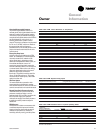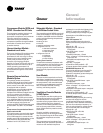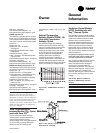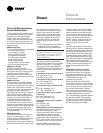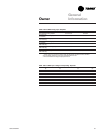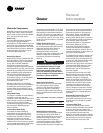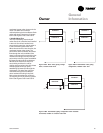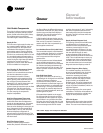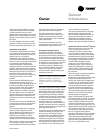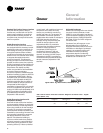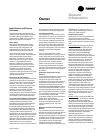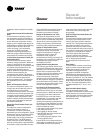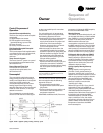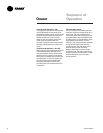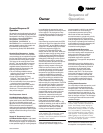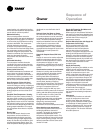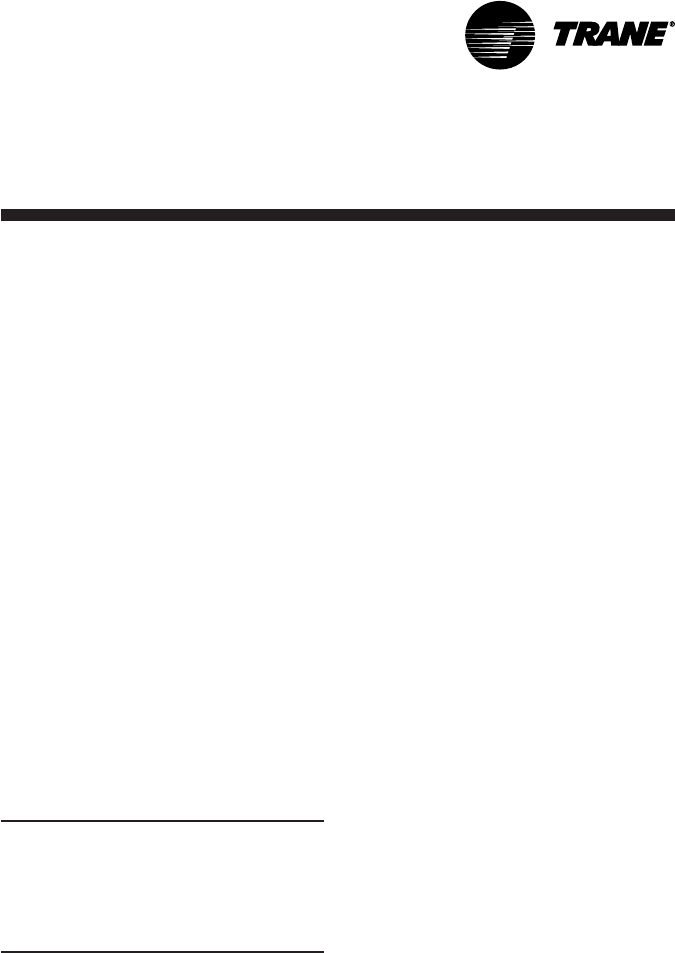
SCXG-SVX01B-EN 87
Owner
mode at the HI panel. When in bypass
mode, VAV boxes need to be fully open.
The self-contained unit will control
heating and cooling functions to maintain
setpoint from a user-defined zone sensor.
Supply air static pressure limit is active in
this mode.
For more detailed information on VFD
operation, reference the Square D VFD
technical manual that ships with the unit.
Airside Economizer Option
Units with the airside economizer option
are equipped with the necessary control
sequences to use outside air for the first
stage of cooling, in occupied or
unoccupied mode and when ambient
conditions are favorable for economizing.
Inherent in the unit controller is the ability
to suppress the setpoint below the
normal unit setpoint. This allows the
building to improve comfort levels when
possible, and at the same time, optimize
building mechanical cooling operation for
peak operating efficiency. An outside air
temperature and relative humidity
sensor are provided to allow monitoring
of reference enthalpy and are field
installed.
If the unit has the ECEM board, econo-
mizer operation enables when the
outside air enthalpy is less than 25 BTU’s/
lb. default (adjustable 19-28 BTU’s/lb.).
During occupied mode, the outside air
damper opens to 15% (adjustable 0-
100% at the HI) for ventilation purposes.
Also, the ability to alter the outside air
damper position to compensate for VAV
supply air modulation is inherent in the
unit controls, and can be enabled by the
operator.
If the unit does not have an ECEM board,
it will economize when the O/A tempera-
ture falls below the O/A economizer
setpoint.
The mixing box fabrication is 16-gauge
galvanized steel. Opposed low leak
damper blades are fabricated from 16-
gauge galvanized steel and rotate on
rustproof nylon bushings. A factory
installed 24V modulating spring return
actuator controls both damper positions.
When outdoor conditions are not suitable
for economizer cooling, the enthalpy
control disables the economizer function
General
Information
and permits the outdoor air damper to
open only to the minimum position.
On water-cooled units, compressor
operation lockout will not occur at low
ambient air temperatures. However,
lockout will still occur via low condenser
water temperature.
The outdoor air dampers drive fully
closed whenever the supply air fan is off,
provided there is power to the unit.
Comparative Enthalpy Control
Comparative enthalpy controls the
economizer operation and measures
temperature and humidity of both return
air and outside air to determine which
source has lower enthalpy. This allows
true comparison of outdoor air and return
air enthalpy by measurement of outdoor
air and return air temperatures and
humidities. A factory-installed control
board, with field-installed outside and
return air temperature and relative
humidity sensors, allows monitoring of
outside and return air.
Note: If comparative enthalpy is not
ordered, the standard method compares
outdoor air enthalpy with the fixed
reference enthalpy. The reference
enthalpy is set at the human interface
panel.
Units with comparative enthalpy control
are equipped with the necessary control
sequences to allow using outside air for
the first stage of cooling, in occupied or
unoccupied mode and when ambient
conditions are favorable for economizing.
Inherent in the unit controller is the ability
to suppress the setpoint below the
normal unit setpoint. This allows the
building to improve comfort levels when
possible, and at the same time, optimize
building mechanical cooling operation for
peak operating efficiency.
Economizer operation enables when the
outside air enthalpy is 3 BTU’s/lb. less
than the return air enthalpy. During
occupied mode, the outside air damper
opens to 15% (adjustable 0-100%) for
ventilation purposes. Also, the ability to
alter the outside air damper position to
compensate for VAV supply air modula-
tion is inherent in the unit controls, and
can be enabled by the operator.
The mixing box fabrication is 16-gauge
galvanized steel. Opposed low leak
damper blades are fabricated from 16-
gauge galvanized steel and rotate on
rustproof nylon bushings. A factory
installed 24V modulating spring return
actuator controls both damper positions.
Airside Economizers with Traq
TM
Damper
Outside air enters the unit through the
Traq
TM
damper assembly and is
measured by velocity pressure flow
rings. The velocity pressure flow rings
are connected to a pressure transducer/
solenoid assembly, which compensates
for temperature swings that could affect
the transducer. The ventilation control
module (VCM) utilizes the velocity
pressure input, the RTM outdoor air
temperature input, and the minimum
outside air CFM setpoint to modify the
volume (CFM) of fresh air entering the
unit as the measured airflow deviates
from setpoint.
When the optional preheat temperature
sensor is installed at the auxiliary
temperature on the VCM and the preheat
function is enabled, the sensor will
monitor the combined (averaged) fresh
air and return air temperatures. As this
mixed air temperature falls below the
preheat actuate temperature setpoint,
the VCM activates the preheat binary
output to control a field-installed heater.
The output deactivates when the tem-
perature rises 5 F above the preheat
actuate temperature setpoint.
Using a field-installed CO
2
sensor with
CO
2
reset enabled, as the CO
2
concentra-
tion increases above the CO
2
reset start
value, the VCM modifies the minimum
outside air CFM setpoint to increase the
amount of fresh air entering the unit. The
setpoint adjusts upward until reaching the
CO
2
maximum reset value. The maxi-
mum effective (reset) setpoint value for
fresh air is limited to the system’s
operating CFM. As the CO
2
concentration
decreases, the effective (reset) setpoint
value adjusts downward toward the
minimum outside air CFM setpoint. See
Figure O-GI-6 on page 88 for an airflow
cfm vs. CO
2
concentration curve.



